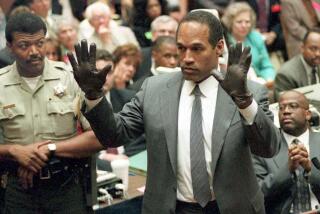Tapping Into ‘Mysteries’ Phone Bank : Television: A ratings bastion for NBC reaches out and touches its audience, solving one out of four cases aired, including the arrest of 79 suspects.
- Share via
The male caller identified himself only as a reader of Tarot cards: “Look for the baby boy on Maui. He’s staying with his father at one of the largest hotels on the island. Look near a volcano that is erupting, or about to erupt. I also see a bright pink orchid nearby.”
The operator dutifully typed the information into her computer. “Thank you for calling,” she said.
“ That child is going to be found,” the man said confidently to himself as he hung up the phone.
The anonymous fortuneteller was one of the roughly 1,500 callers who dialed the 800 number after watching NBC’s “Unsolved Mysteries” last Wednesday night.
From the moment the program airs on the East Coast each week, phone calls ranging from viewer tips to personal pleas for help pour into the 24-hour phone bank in Los Angeles, where 28 operators record information that leads to a substantial number of resolutions. “Unsolved Mysteries,” hosted by the stately Robert Stack, Emmy Award winner for “The Untouchables,” has solved an average of nearly two mysteries per episode this season.
The most curious mystery, however, may be the popularity of the reality-based series, produced for an estimated $700,000 per episode--or slightly more than half the cost of most one-hour dramas. Tagged by critics as tabloid TV when it premiered in 1987, “Unsolved Mysteries” has steadily added fans to become a ratings bastion for NBC. The series, which has been renewed for next fall, currently ranks No. 11 among 131 prime-time network shows that have aired this season.
Ratings show that the majority of those viewers live outside the nation’s big cities. A sample of an evening’s phone calls reveals the far-reaching net that “Unsolved Mysteries” casts each week.
“I was on an airplane last Saturday from New York to Cincinnati, and I swear that guy was sitting beside me,” exclaimed Poppy Forman, 18, who was watching with her husband last Wednesday in Oceanside when she telephoned.
The profile she was referring to involved an estranged husband from Los Angeles, Sergio Farina, who allegedly ran off with his 7-month-old son, Marcus. Marcus has a malfunctioning thyroid gland that may result in Graves’ disease if not properly cared for.
“He had an unforgettable face,” Forman said excitedly. “He had short hair, no sideburns and a heavy accent. . . . He was really cute.”
“I know how to eliminate what leads to Graves’ disease,” volunteered one ornery man who phoned in. “Has to do with fluoride in the water. Nobody will listen to me because I don’t have no Ph.D. But I’m the only man to beat colon cancer. I’m 70, and I could outrun Bob Stack.”
By evening’s end, the “Unsolved Mysteries” staff had whittled the Farina calls down to five “hot tips”--or serious leads. He was “recognized” as an apartment tenant in Los Angeles, a hotel guest in Washington and at a health spa in Oregon, while believed to be working as an actor in New York and a dancer in Las Vegas.
“That’s typical. But we’ll have agents run each of these leads down,” said Karen Gardner, a special agent with the Federal Bureau of Investigation in Los Angeles, who haunts the phone bank Wednesday nights. Law enforcement officials from around the country frequently travel there when crimes from their jurisdictions are portrayed on “Unsolved Mysteries.”
Three weeks earlier, Gardner was on hand when a “hot tip” came in on Cheryl Wooten, suspected by police of the murder of her aunt and uncle in Lewis Chapel Mountain, Tenn. “The show wasn’t off the air 45 minutes before she was in custody in Texas,” Gardner said proudly.
“The calls that we roll troops on are those where the people insist they know who the person is, or when calls come in clusters, when several phone calls identify the same person,” Gardner explained.
Each week, “Unsolved Mysteries” showcases carefully staged re-enactments, matching exact details and often using people who were involved in the real-life occurrence. The events depicted fall into such categories as unexplained deaths, wanted fugitives, missing persons, lost loves and lost heirs. There’s also an occasional Big Foot or UFO sighting tossed in for good measure--”what we call the ooga booga stories,” executive producer John Cosgrove said.
“We’re on at 8 p.m., and to do a solid hour of crime stories just seems a little bit heavy,” Cosgrove said. “So what we want to do is keep the audience involved by throwing change-ups at them.”
In 1985, Cosgrove and his partner, Terry Meurer, did three missing children specials for NBC called “Missing: Have You Seen This Person?” To their surprise, 25 people were found as a result of those specials. “The missing children movement was a trend, sadly, that became less a headline and moved into the background,” Cosgrove said. “So we expanded the idea of audience interaction to include all kinds of cases.”
The executive producers--who have a new reality series, “Against All Odds,” premiering on NBC April 19--believe the interactive nature of their show is what keeps viewers coming back. Research has shown that the update segment where cases are solved is the program’s most popular.
“Even though our stories are 10-minute teases, people want to know what happened, if the mystery was solved,” Meurer said. “So they don’t mind waiting a week or two till the updates are aired.”
“Although you’re watching a show without an ending, you know there is a potential for an ending,” Cosgrove added.
Every week, Stack appears on camera and says ponderously, “Perhaps you may solve a mystery.” Judging from phone calls last week, many faithful viewers do tune in on the slim chance that they might be living next door to a criminal or know someone’s lost love.
“This is not just your run-of-the-mill TV show,” insisted Frances Sachen, 53, who phoned in a tip from Kansas City, Kan. “You watch every week and wonder if you can spot someone. If not, then you stay on the watch for that person after you see the show.”
Many viewers questioned expressed sympathy for the subjects of “Unsolved Mysteries,” suggesting that true stories about people in emotional upheaval is simply good television.
“My heart goes out to these people. I laugh with them, I cry with them, I pray for them,” confessed a 33-year-old Artesia woman. “I went through a lot of problems with my daughter’s father. I’m surprised he’s not on the show.”
In fact, many viewers do seek personal retribution, relief or rescue from “Unsolved Mysteries.” Each week the staff is deluged with hundreds of phone calls and letters from people who want assistance in solving their own personal dilemmas.
One tentative female caller last week pleaded nervously for help finding her husband: “He’s been gone 16, going on 17, years. And he’s never paid any child support. I think he changed his name or Social Security number. I’ve gone through every legal service. I’ve even declared him dead. Can you help me?”
The woman was patiently given the standard response--to sum up her situation in a typed letter and send it to the program with any photos. A dozen researchers dig through the mountain of requests and pitch them to the show’s producers in weekly staff meetings.
“I think it touches home to see they’re trying to help people,” said Lisa Quint, 20, of Eugene, Ore. She phoned the show last week to elicit aid in locating her mother, who left when she was 7 months old. Worried about the health of her 2-year-old daughter, she was seeking vital family medical history.
“You know this show is real--it’s not fiction,” Quint said. “It’s not like watching ‘The Cosby Show.’ ”
But there does appear to be some blurring of reality and fantasy. “People love Robert Stack,” explained Traci Bergsing, one of the phone operators. “They call and want to tell their problems to Bob.”
“When you’re dealing with all these evil, venal, nasty, brutal stories, somehow a man like Robert Stack standing in a pool of light gives viewers a sense that all is well in the world,” former producer Chris Pye suggested. “He offers a ray of hope.”
So does “Unsolved Mysteries.” In five years, the program has solved about 60% of its lost love cases and located 18% of its missing heirs. Overall, the program solves one out of four cases aired, including the arrest of 79 suspects.
“In our own unique way, we all want to make a contribution to the betterment of the community, the society we live in, and ‘Unsolved Mysteries’ offers that tangible opportunity,” said Swanson Carter, the FBI agent in Washington assigned to work with “Unsolved Mysteries” and “America’s Most Wanted,” the 4-year-old Fox series that has helped spawn 196 arrests.
Last year, Becky Granniss, 46, was watching “Unsolved Mysteries” in Phoenix when she thought she recognized Gregory Richard Barker--an alleged killer. “They showed a picture of this guy,” Granniss said last week. “I was sitting in my living room saying, ‘I know that man.’ My sister-in-law was home watching too. She called me right away and said, ‘Are you watching ‘Unsolved Mysteries?’ ”
Granniss tabbed Barker as Alex Graham, a telephone solicitor in the professional building where she was a maintenance worker, and called “Unsolved Mysteries.” Barker was arrested 18 hours later.
“You kind of watch with the idea, ‘Gee, is there somebody I’m going to know on here?’ It’s exciting to watch that type of show, especially when it’s real, but not real to you,” Granniss said.
After helping catch a criminal, however, Granniss said that the fascination has worn off. She rarely watches “Unsolved Mysteries” now.
More to Read
The complete guide to home viewing
Get Screen Gab for everything about the TV shows and streaming movies everyone’s talking about.
You may occasionally receive promotional content from the Los Angeles Times.






